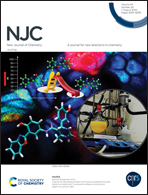Synthesis of graphene oxide with a lower band gap and study of charge transfer interactions with perylenediimide†
Abstract
The optical and electrical properties of graphene oxide (GO) have been modulated by using different chemical and physical routes. In the current work, solution processable GOs, i.e., mGO-1 & mGO-0.5 with band gaps of 1.50 eV and 1.35 eV respectively, have been prepared by optimizing graphite oxidation conditions to deliver properties similar to reduced graphene oxide (rGO) without employing tedious reduction steps. GO has been characterized by FT-infrared (FTIR) spectroscopy, UV-Vis absorption, Raman spectroscopy, X-ray diffraction (XRD) and X-ray photoelectron spectroscopy (XPS) to establish a low degree of functionalization and large sp2 crystallite size (66 Å) in synthesized GO (mGO-0.5). We have further performed a study on the interaction of GO with n-type organic semiconductor materials, i.e., perylenediimide (PDI). Well aligned energy levels, calculated by electrochemical analysis, facilitate electron transfer from GO to PDI molecules as evident from transient absorption spectroscopy (TAS). This work introduces a facile methodology for the preparation of solution processable rGO like lower band gap GO to be used as the donor material in organic electronic devices especially organic solar cells.



 Please wait while we load your content...
Please wait while we load your content...